ADVANTAGES & DISADVANTAGES
As a renewable resource, wind energy offers a number of advantages. Wind energy is a clean fuel source that does not result in air pollution. Wind turbines do not produce harmful emissions like coal or natural gas fired power plants. Wind is a renewable source of energy and the nation’s wind supply is abundant and unlimited. Wind also represents a domestic source of energy, which means that the U.S. does not need to rely on the resources of another nation or region in order to produce energy. Wind energy is one of the lowest-priced renewable energy methods, costing roughly 2-6 cents per kilowatt-hour (kW/h). Wind turbines can be constructed in rural areas (including farms and ranches), which can benefit the economy in these areas. [1]
While there are many advantages to using wind as an energy source, the use of wind power also comes with some challenges and disadvantages. In order to see widespread adoption of this new energy technology, wind power must be cost competitive with conventional energy sources. In 2020, the installed cost of wind projects averaged $1,460/kW. Even though the cost of installing wind projects has fallen more than 40% since 2010,[2] wind energy technologies require a higher initial investment as compared to fossil-fueled generators.[3] Since 2010, the price of wind turbines also dropped more than 40%, and now averages $775–$850/kW.[4]
A 2019 NREL report estimated the levelized cost of energy (LCOE) for land-based and offshore wind power plants in the United States. A large amount of the LCOE for land-based projects (47.3%) is in the turbine itself. For both fixed-bottom and floating offshore projects, the largest LCOE is allocated to the balance of system and operation and maintenance (O&M). The capital expenditures for land-based projects average $1,436/kilowatt; on the other hand, fixed bottom and floating offshore projects average $4,077/kilowatt and $5,328/kilowatt respectively.[5]
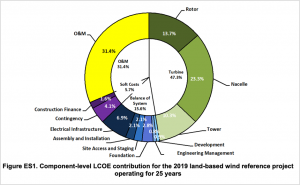
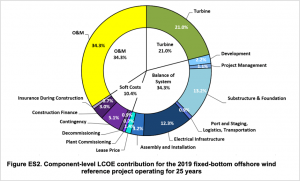
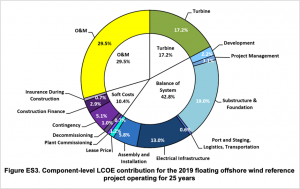
Sites that generate a large amount of wind on a relatively consistent basis are often located in remote or rural locations that are far from cities, which need significantly more electricity. Other challenges include the fact that turbines can cause noise pollution and negatively impact the visual landscape of areas. Wind plants can also be a threat to local wildlife, like birds and bats. Moreover, installing wind-turbines on land might not be the most profitable use of that land.[6]
The figure below shows the locations of land-based wind power development in the U.S. and the corresponding wind power capacities. Texas is the clear leader with 32,686 MW installed at the end of 2020, which is nearly three times the capacity as Iowa, the next-highest state. [7]
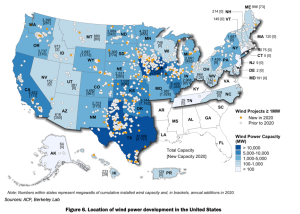
Source: DOE
The figure below shows the 2020 wholesale market value of wind power, at a project-level, and illustrates the variability in market value within each region.
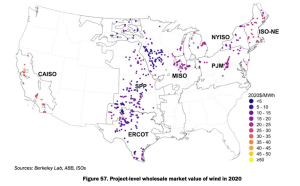
Source: DOE
Updated January 2024 by Jennifer Ostromecki

Comments are closed.